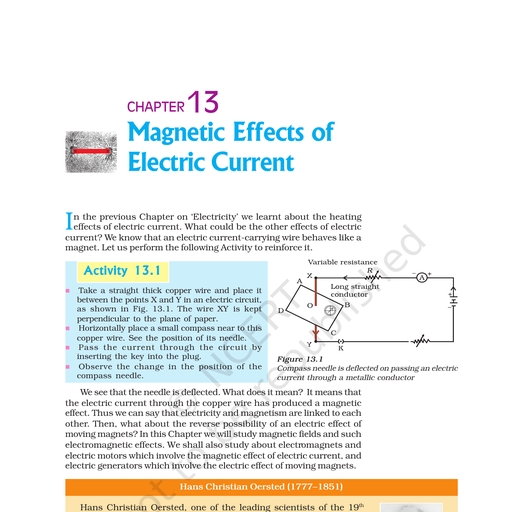Page 2 :
It is very important to note that the electrification of the body (whether, positive or negative) is due to transfer of electrons from one body to another., , MUR eRe ice Mle AR MU Metall mel, electrons makes the body positive., , If the electrons are gained by a body, then the excess of electrons makes the, body negative., , If the two bodies from the following list are rubbed, then the body appearing, early in the list is positively charges whereas the latter is negatively charged., , CES UML Ame MR Yelle MLTR ES ae sl ae tT, Sulphur, Rubber, Ebonite., , Column! (+ve Charge) Column Il (-ve Charge), Silk, Pie ae aol CAA Us] e Tam Ett, Polythene, , Comb, , Properties of Charges:, Re Sas a eee Mert Eel] Dos hoe, . Like charges repel and unlike charges attract each other., Charge is a scalar quantity., nature, . Charge is quantized., , i.e. Electric charge exists in discrete packets rather than in continuous, amount., , It can be expressed in integral multiples fundamental electronic charge, (e = 1.6 x 1019 C), , foe a=) where n = 1, 2, 3,, . Charge is conserved, , MCE elle ot Mola ofS eh ETT] negative charges in an isolated, system remains constant., , eg. When a glass rod is rubbed with silk negative charge appears on the silk, and an equal amount of positive charge appear on the glass rod. The net, charge on the glass-silk system remains zero before and after rubbing., , USCS ela ite MoT ml olor Sel to
Page 3 :
Note: Recently, the existence of quarks of charge ‘4 e and 7% e has been, postulated. If the quarks are detected in any experiment with concrete, practical evidence, then the minimum value of ‘quantum of charge’ will be, either % e or % e. However, the law of quantization will hold good., , Coulomb's Law — Force between two point electric charges:, , The electrostatic force of interaction (attraction or repulsion) between two point, electric charges is directly proportional to the product of the charges, inversely, proportional to the square of the distance between them and acts along the line, joining the two charges., , Strictly speaking, Coulomb's law applies to stationary point charges., be, Faq,q, os, Fa1/r?, , be Nee eM ehMac f, , ue Ein proportionality called, electrostatic force constant or, Coulomb constant., , Co a oa, r2, , i, In vacuum, k= 7 where €, is the permittivity of free space, LE, , J, In medium, k= where € is the absolute electric permittivity of, , Cuts the dielectric medium, , The dielectric constant or relative permittivity or specific inductive Capacity or, dielectric coefficient is given by, , , , i A The Fd, , * Invacuum, Fe=, Cot cd, , i be Ted, , In medium, Fe=, Ctr r, , CY ae acer ai, , i], = 8.9875 x 109 N m2 C2 = 9x 10°N m?C2, Le
Page 4 :
Coulomb’s Law in Vector Form:, , , , In vacuum, for q, q,>0,, , > i Tne] *, ane Cot i, , , , , , ‘J rae al, , Lory, Cate fe, , , , , , In vacuum, for q, q, <0,, , , , i beth), , Ss, F,, Cian r, , 2=, , (in all the cases), , , , , , , , , , , , , , 1 seme rg 6 > 1 emery :, a Cf e ae Cn 2, , x, aa, , , , , , , , Note: The cube term of the distance is simply because of vector form., Otherwise the law is ‘Inverse Square Law’ Cale, Units of Charge:, , In SI system, the unit of charge is coulomb (C)., , One coulomb of charge is that charge which when placed at rest in vacuum at a, distance of one metre from an equal and similar stationar, , y charge repels it and, is repelled by it with a force of 9 x 109 newton., , Der Cece ECM ETT tet] Puree Mc lite ello met is ree, , In egs electrostatic system, k= 1/K where K is ‘dielectric constant’., , For vacuum, K = 1. Care, , Sara, If q, = q, = q (Say), r= 1cmandF =1 dyne, then q = + 1 statcoulomb., , In egs electromagnetic system, the unit of charge is ‘abcoulomb’ or ‘emu of, charge’.
Page 5 :
Electric Field:, Electric field is a region of space around a charge or a system of charges, within which other charged particles experience electrostatic forces., , Theoretically, electric field extends upto infinity but practically it is limited to a, LSet ie lalet-e, , Electric Field Strength or Electric Field Intensity or Electric Field:, , Electric field strength at a point in an electric field is the electrostatic force per, , unit positive charge acting on a vanishingly small positive test charge placed, at that point., , , , +q +, , bake), CO, , ah, Le oe SEE, a aad, F, , F, , , , oe —~—__—, , q- Source charge, q, - Test charge, F -Force & E- Field, , a >, , => rT i a), eee o ack rg E= a, , \q—>0 Aq rn C3, The test charge is considered to be vanishingly small because its presence, , should not alter the configuration of the charge(s) and thus the electric field, which is intended to be measured., , LS Toh ois, , 1. Since q, is taken positive, the direction of electric field (E ) is along the, direction of electrostatic force ( F )., , - Electrostatic force on a negatively charged particle will be opposite to the, direction of electric field., , . Electric field is a vector quantity whose magnitude and direction are, uniquely determined at every point in the field., , SI unit of electric field is newton / coulomb (NC*).






































